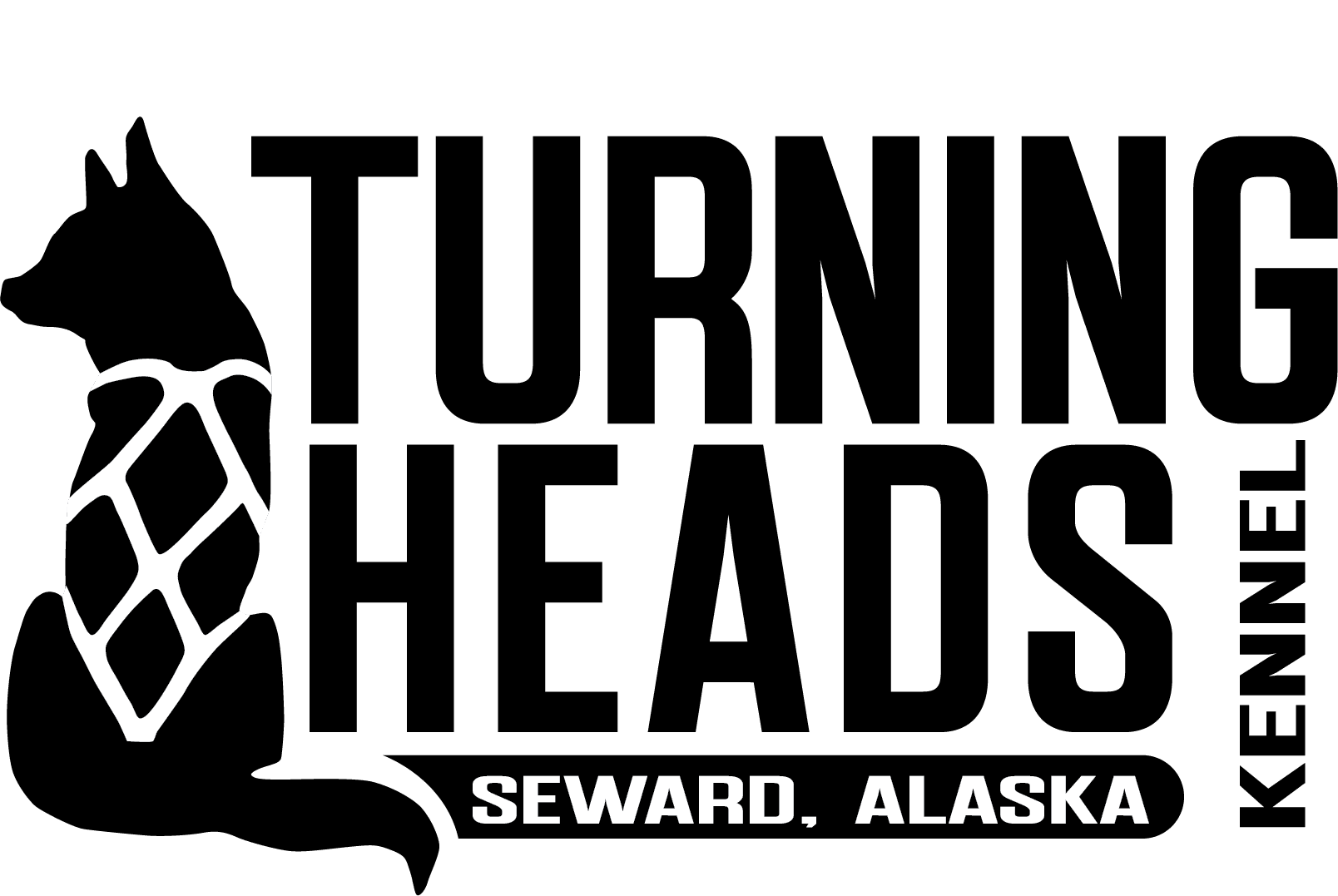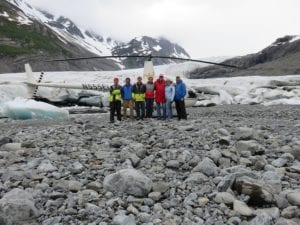In sled dog racing, it’s important to find the right balance between running and resting so that your team is as strong and efficient as possible. Not enough rest, and a musher risks wearing their dogs out but too much rest is equally problematic as too much rest can put you far behind the competition. Finding a good rest and run schedule for your sled dog team is essential to being a competitive long distance dog sled racer.
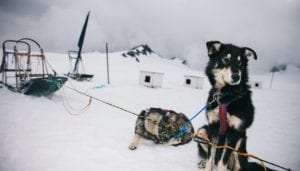 One of the most interesting things about the 1,000-mile long Iditarod sled dog race is that very little rest is actually structured within the rules of the race. There are only 3 mandatory rests throughout the 1,000 mile long race: a 24 hour layover to be completed at any checkpoint, an 8 hour layover to be completed at a checkpoint on the Yukon river, and an 8 hour layover at White Mountain 77 miles from the finish line. A musher cannot combine their mandatory 8 hour layover with their 24 hour layover.
One of the most interesting things about the 1,000-mile long Iditarod sled dog race is that very little rest is actually structured within the rules of the race. There are only 3 mandatory rests throughout the 1,000 mile long race: a 24 hour layover to be completed at any checkpoint, an 8 hour layover to be completed at a checkpoint on the Yukon river, and an 8 hour layover at White Mountain 77 miles from the finish line. A musher cannot combine their mandatory 8 hour layover with their 24 hour layover.
It should go without saying that 40 hours of rest is not is not enough to get a dog team the full 1,000 miles down the trail. Mushers must decide their own rest and run schedule to suit their teams needs. This is what makes Iditarod so fascinating: mushers have to figure out how to structure their race to maximize their dog team’s capabilities.
Every Dog Team Is Different
Every dog team is different so ultimately we see many different rest and run strategies emerge throughout the race. Mushing dogs competitively means finding what works for your dogs. Some dog teams are better at going fast for short distances and taking longer rest. Other dog teams excel at running longer and farther than the competition at a slower pace; the slower pace is less taxing on the dogs and, in theory, these dogs need less rest. A main component of training is figuring out how you as a musher want to run your team and what your dog team excels at.
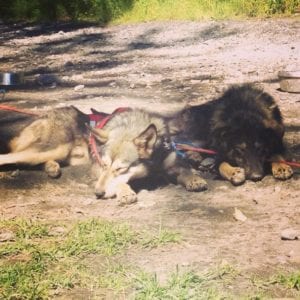
Of course, there are personal considerations to take into account as well. In long distance racing, having adequate sleep helps mushers make crucial decisions and avoid costly errors that could put them out of the competition. It is just as important for the musher to train to their rest and run schedule as it is the dogs.
Making Rest Count
In order to make rest beneficial for the dogs, there are a number of things that we as mushers do. The most important is that we provide them with a warm, relaxing, and familiar environment that puts our dogs at ease. While we can’t necessarily go out and run the race beforehand, we can practice the basics of camping with our dogs in training so that they know what to expect.
Although each musher may have a different “order of operations” we generally all do something rather similar. First, we make a comfortable bed for our dogs to sleep. On the trail, we do this by laying out straw and making “nests” for the dogs. The straw provides a layer between the dogs and the snow, helping to insulate the dogs and keeping them warm. It is also a good signifier to the dogs that the team is going to be stopped for awhile
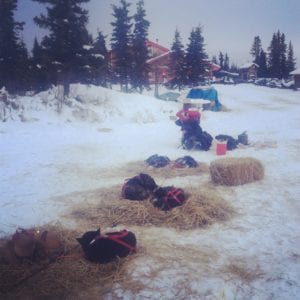
The next thing we do is feed the dogs. This can be a chore if we are out on the middle of the trail as we have to melt snow to make warm water for the dogs. We feed a warm wet stew-like meal full of beef, chicken, fish, different types of fat, and kibble. The meal is loaded with high-energy fats and proteins to help our dogs stay warm and to help them refuel their bodies. Sled dogs consume roughly 12,000 calories during racing and training to help them stay warm and fuel them down the trail.
After eating, the dogs then curl up and go to sleep. As a musher, we then began working on each dog, one at a time. What we do for each dog varies, but generally it includes rubbing their feet and putting any necessary ointment on. We also like to massage our dogs wrists, shoulders, and lower back. We can spend upwards of twenty minutes on each dog. We use massage ointments on our dogs to help relax them, increase blood flow, and to help prevent injury.
Amazingly a dog team is rejuvenated and ready to head back down the trail for another run after their rest which can be as short as 2 hours or as long as 8, depending on the musher’s strategy. The dogs are excited to get back out on the trail and continue running.
Planning Rest
Believe it or not, when we prepare for a race, we prepare by planning where we will rest and how long. This helps us figure out how to pack our drop bags for each checkpoint. Drop bags are bags of gear located at the checkpoints along the race trail. It’s how we resupply crucial gear like dog food and human food. Having checkpoints allows us to use dogs bred for endurance rather than strength. Not having to haul our own gear allows us to use a faster “race” dog rather than the hefty weight-pulling dogs used during Alaska’s gold rush era.
What We’ve Learned From Our Sled Dogs
When you own sled dogs, you stay busy. When you own your own business, it seems you stay even busier. Between our kennel responsibilities and our work responsibilities it seems like we never stop working. The trouble with that, however, is that no human can sustain that pace. Just like a sled dog needs time to rest and recover after a long run, it’s important that we, as people, take time for ourselves to recuperate and to rejuvenate.
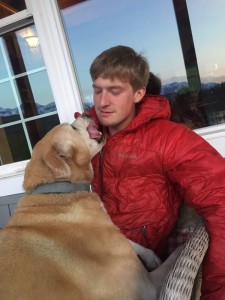 We’ve learned that just like we have to plan rests for our dogs, we also have to plan rests for ourselves. If we don’t, we run into the same problem our dogs do: we burn out.
We’ve learned that just like we have to plan rests for our dogs, we also have to plan rests for ourselves. If we don’t, we run into the same problem our dogs do: we burn out.
This summer we are making a commitment to taking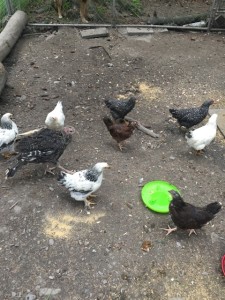 more time off to be with each other and relax together. We’ve worked on finding new hobbies. Travis has begun mountain biking and I’ve started painting again. I also have started a chicken coop and have 8 laying hens.
more time off to be with each other and relax together. We’ve worked on finding new hobbies. Travis has begun mountain biking and I’ve started painting again. I also have started a chicken coop and have 8 laying hens.
The chickens should be fun and give us something new to do. I’ve enjoyed watching them in their temporary coop and have also enjoyed working on painting their new coop.
We spent a few blissful days watching our friends house. It was so soothing getting to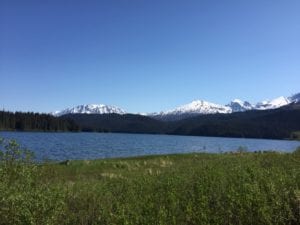 leave the kennel and stay down the road from our house. The peace and tranquility that allowed gave us some much needed time to reconnect. We woke to beautiful mountain views and got to enjoy listening to loons at night. We also went kayaking one day and jet skiing another.
leave the kennel and stay down the road from our house. The peace and tranquility that allowed gave us some much needed time to reconnect. We woke to beautiful mountain views and got to enjoy listening to loons at night. We also went kayaking one day and jet skiing another.
Our good friend and fellow Iditarod Wade Marrs and his girlfriend, Sophie, came to visit and Travis was able to show them our glacier dog sledding operation. Wade had previously worked in Skagway; getting to share that with him was great.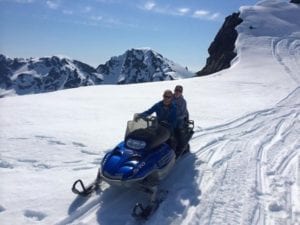 Travis took him and Sophie snow machining. We had great weather while Wade and S0phie visited and are looking forward to them returning in a few short weeks with Sophie’s family.
Travis took him and Sophie snow machining. We had great weather while Wade and S0phie visited and are looking forward to them returning in a few short weeks with Sophie’s family.
My family also came to visit and we spent a great week hanging out. My parents filled in where needed, helping us in the office and at the kennel. We redid our kennel office while they were in town, enjoyed some scenic flying, and just enjoyed each others company.
Planning rest is important not just for sled dogs but for people too and we will be doing more of that this year for ourselves!
